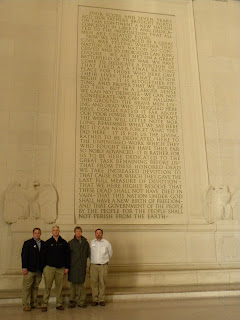The final day of the national trip started at 4:45am as the group had to gather at the hotel lobby in Nogales to load the bus that would take us to the Phoenix Sky Harbor International Airport and fly back to home.
While there were no official activities this day, other than get us back home safely, we must admit that after 11 days of intense travel and exposure to multi dimensional topics, we were full of deep thoughts and views on the context received.
On the two hour plus ride to the airport, some Fellows decided to rest and sleep, others were pensive looking at the beautiful sunrise and the Arizona Mountains, others continued to dialogue about some of the topics covered, and others started to catch up on work issues.
Putting together this trip was a monumental task for those involved and we can’t finish this set of blogs without acknowledging the professionals that work diligently to ensure this was a successful adventure.
We would like to thank the Foundation for all the resources devoted to the trip, this has been a profound experience and we can’t thank you enough for that. We would also like to thank Western Growers Association for their sponsorship; your patronage is highly appreciated.
Thank you to Bob Gray, President and CEO, for helping securing visits, facilitators and for spending with us the week in Washington, we enjoyed your company and conversing with you during breaks and our travel time within the city.
Dr. Charlie Crabb, Program Advisor, thank you for being with us the entire trip, for all the wonderful pictures you unselfishly took in every event and site we visited, and for all your assistance and guidance during this time. Dr. Robert Flores, Campus Coordinator at CalPoly San Luis Obispo, thank you for coming along with us and sharing your views these past days, additionally, your sense of humor is invaluable. Emily Clark, Enterprise Coordinator, for holding the front office together while other staff members traveled with the group. Judy Sparacino, Program Coordinator, you are the star behind the scenes, we know you do a lot without saying much, what a great example of servant leadership.
 |
| Dr. Stephen Randolph, USAF (Ret.), Dr. Robert Flores, Bob Gray, and Dr. Charlie Crabb at the Albert Einstein statue in Washington, DC |
Our appreciation also goes to all the guest speakers and everyone from their staff that made possible their participation. Your knowledge and information provided on the many topics covered during the trip was impressive and created profound dialogue amongst ourselves, so thank you again for volunteering your time and for the stellar presentations.
Mary Kimball (Class 32) and John Azevedo (Class 37) for joining us during our visit to Gettysburg.
To all members of the DC Exchange, for joining us in different events and for the hosting us at the USDA headquarters, we enjoyed getting to know you and thank you for the warm reception.
 |
| Dan Rodrigues (right) conversing with a guest at the DC Exchange reception. |
Everett Rhodes, Project CENTRL Director and all the members of the program for organizing all the tours, sites’ visits, and for contacting and confirming all the guest speakers in Arizona. Everything was highly organized. A special thank you to Dan Bell, President of ZZ Cattle Corporation, for opening the doors to his house and hosting the dinner with members of CENTRL and other guests. Dan, the peach cobbler with vanilla ice cream dessert was delicious!!!
 |
| Guests and Class 41 Fellows in Project CENTRL's reception at Dan Bell's house. |
We also want to thank our employers, direct reports, owners, and business partners for picking up the work while we were away. Your assistance and support is essential for us to be part of this program.
Last, and certainly not least, we want to express our deepest gratitude to all our families for their encouragement, we could not do this without all your patience and understanding while we are away in our journey, we love you all.
Well, this brings Class 41 National Trip to its conclusion. It is now time to get back to work and apply the knowledge and principles acquired to our professional and personal lives. Our journey continues…
 |
| A few of Class 41 Fellows at the Los Angeles International Airport prior to departing to their final destinations. |
On behalf of all Fellows of Class 41 we say “so long folks".
- Respectfully and meekly submitted by Matt Fisher, Christine Ivory, and Jorge Suarez





















